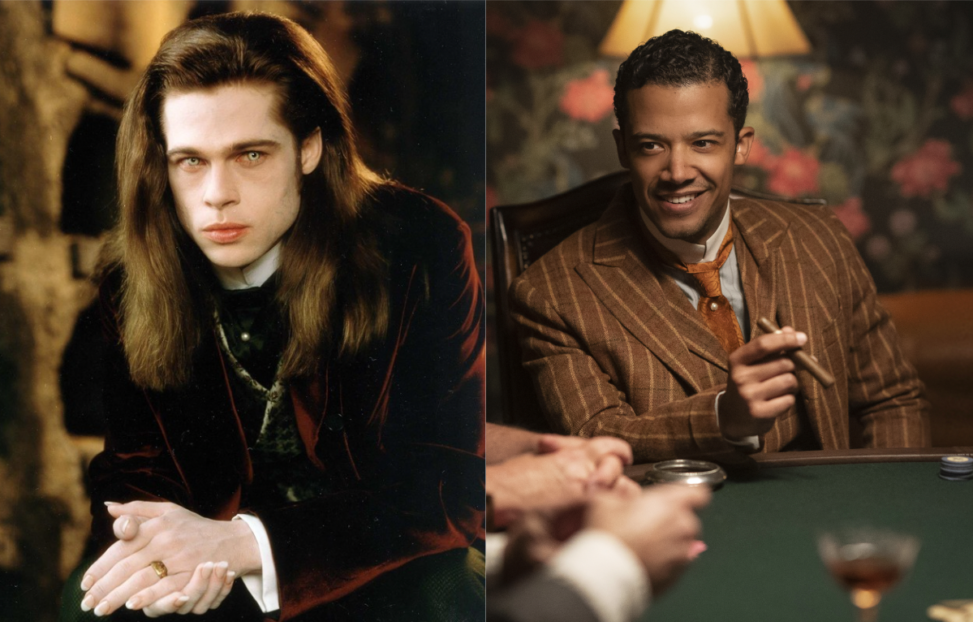Louis du Pointe du Lac was first introduced to audiences in 1976 with the release of Interview with the Vampire—the first book of Anne Rice’s 13-part series, The Vampire Chronicles. As a vampire, Louis broadly signifies the stereotypical associations of The Vampire: parasitism, passion, seduction, violence, and the state of being ‘outcast’. I will explore the changes in Louis’ characterisations between the 1976 book and the 2022 TV show of the same name and how that has added to or taken away from these associations.
Louis is the initial protagonist in both the novel and the TV series. He is portrayed as reliable, soft-hearted, family-oriented, albeit passive and melancholy. After the suicide of his brother, he is drawn into depression and alcoholism. Now suicidal himself, Louis welcomes death in any way, only to be transformed into a vampire. As described in both the book and TV series, the state of vampirism is considered both a death and rebirth.
Very little remains consistent in Louis’ depiction between both mediums outside of these overarching themes. In the book, Louis du Pointe du Lac is a wealthy white man in 1790s Louisiana who, at the time of becoming a vampire, is overseeing his family’s indigo plantation (along with the slaves on it). This Louis lives in a bubble of privilege—one that goes uninterrogated throughout the plot.
Louis in the novel is a bit of a blank wall—white enough, handsome enough, wealthy enough, and capable enough that everything that happens to him in the books seems plausible without really making him special. In the 2022 television series, Louis has been utterly transformed.
Race is the most immediately obvious and significant change. In the series, Louis is a black man living in New Orleans in the 1910s. Though successful, Louis’ money comes from less than acceptable sources (brothels), as these are the only avenues of business open to him as an African American. His race, coupled with the ‘deviant’ nature of his work, does not grant him the same position of authority and privilege that the book’s depiction of Louis had so easily. Though Louis is more respected than other black men of his time, he is faced, at every turn, with racist pushback from humans and vampires alike.
Dale Hudson described a state of “unnatural whiteness” in conventional images of vampires¹. This whiteness, he said, has become fetishised in contemporary depictions like The Vampire Chronicles. Whiteness and Vampirism have since felt inseparable. Vampires seem to hold an inhuman, aristocratic grace that is attributed solely to those of “European” blood. While other creatures like werewolves and witches could come from different cultural and ethnic backgrounds, vampires seemed an exclusively white concept.
Richard Dyer believed that power lay in the ability of one race to claim to speak for all of humanity, to take the position of ‘just’ human, while everyone else is racialised². Vampires have always represented universal themes of ostracism and marginalisation, with Anne Rice herself referring to her vampires as “lost souls”. Western media has maintained this depiction using white characters for fear that making them a different race would ‘racialise’ the role instead of speaking for the human condition. “Raced people can’t do that—they can only speak for their race,” said Dyer. “But non-raced people can, for they do not represent the interests of a race.”
The TV adaptation dispels this assumption. A black man, Louis carries the regal otherworldliness of a vampire as good as any. Yes, he is racialised—you cannot escape it as a black man in 1910s America. But his ethnic background and racial struggles do not take away from the narrative—it adds to it. Louis’ righteous fury over his racist mistreatment as a black man transfers cleanly into a righteous fury over his ostracism as a vampire.
This depiction is important because it contextualises and empathises with the rage of the black experience in a genre that, historically, black people have been shut out of in any role but victim. In the books, for instance, Louis burns his plantation and murders his slaves to protect his identity. In the TV show, Louis murders a white businessman who had been exploiting him and other black business owners. While both are inherently selfish actions, the latter is undoubtedly more sympathetic.
Though conservative in its depictions of race, the book was far more liberal with sexuality. Anne Rice’s narratives “often include non-traditional family structures, focus on homosocial relationships, and include characters that could be classified as asexual or bisexual rather than heterosexual.”³ Still, most of these depictions of non-traditional sexuality were buried in subtext. In the TV series, Louis is depicted as a homosexual man grappling with his desires, shame, and romances.
This has relevant effects in reshaping the narrative. Themes of companionship prevalent in the books can now be depicted in the form of emotional love, co-dependency, and intimate partner violence. The dynamic of an interracial relationship between Lestat and Louis also adds another interesting layer to the story.
Vampires in media have always been very connected with concepts of sex and sexuality⁴, and despite this, there has been a lack of overtly gay representation in mainstream vampire media. Though the novel took significant strides in redefining masculinity⁵, having two male vampires openly sexual and sincerely romantic with one another created a new level of normalisation. The decision to make Louis an undeniably gay man is also impactful for mainstream perceptions of queerness—especially black queerness—in historical contexts.
The depiction of a complicated, morally grey character with recognisable fury, trauma, sadness and desire is important for people to connect with the character of Louis. In the TV series, Louis’ blackness allows a depiction of resilience and pride despite constant adversity. His queerness allows for an interrogation of blood versus chosen family and proves how friendship and companionship can enrich lives. His position as a victim of domestic abuse provides a layered exploration of co-dependence, obsession, and what it means to be a male abuse victim.
All of these are relevant to the key associations of The Vampire I had outlined at the start of my essay. In my opinion, none could have been as effectively depicted with a white, wealthy, sexually ambiguous Louis du Pointe du Lac.
The Interview with the Vampire series was released on AMC, an American basic cable television channel, and put up for streaming on MAX. As such, it was available to mainly American audiences for its first two seasons. It had minimal promotion and almost no international audience, so it wasn’t well known. There were, thus, few negative reactions – rare for adaptations of popular IPs with race-swapping involved. The show has recently been put on Netflix and will presumably be pushed to wider audiences upon the release of its third season. It remains to be seen what the reaction will be when it has a wider platform.
Endnotes
1. Hudson, Dale. Vampires, Race, and Transnational Hollywoods. Edinburgh University Press eBooks, 2017. https://doi.org/10.1515/9781474423090.
2. Dyer, Richard. “The matter of whiteness.” White privilege: Essential readings on the other side of racism 3 (2005).
3. Ames, Melissa R. “Vamping up Sex: Audience, Age, & Portrayals of Sexuality in Vampire Narratives.” Journal of Dracula Studies 12, no. 1 (January 1, 2010): 83. https://research.library.kutztown.edu/cgi/viewcontent.cgi?article=1068&context=dracula-studies.
4. Ibid.
5. Zurutuza, Kristian Pérez. “The Vampire as the Gender and Racial Construction of Western Capitalism’s White Masculinity in English and American Gothic Literature.” SSRN Electronic Journal, November 1, 2015. https://papers.ssrn.com/sol3/papers.cfm?abstract_id=2960719.
Bibliography
Ames, Melissa R. “Vamping up Sex: Audience, Age, & Portrayals of Sexuality in Vampire Narratives.” Journal of Dracula Studies 12, no. 1 (January 1, 2010): 83. https://research.library.kutztown.edu/cgi/viewcontent.cgi?article=1068&context=dracula-studies.
Dyer, Richard. “The matter of whiteness.” White privilege: Essential readings on the other side of racism 3 (2005).
Hudson, Dale. Vampires, Race, and Transnational Hollywoods. Edinburgh University Press eBooks, 2017. https://doi.org/10.1515/9781474423090.
Zurutuza, Kristian Pérez. “The Vampire as the Gender and Racial Construction of Western Capitalism’s White Masculinity in English and American Gothic Literature.” SSRN Electronic Journal, November 1, 2015. https://papers.ssrn.com/sol3/papers.cfm?abstract_id=2960719.


Provide Feedback